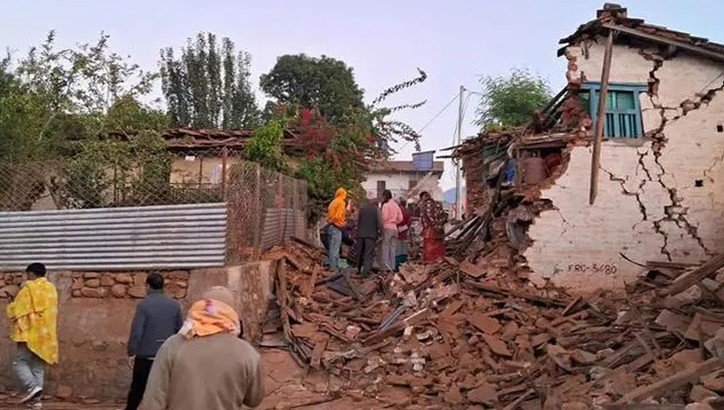Strong tremors jolted the Delhi-NCR region on Thursday morning, sending people out of homes and offices in panic. A 4.4 magnitude earthquake struck near Jhajjar, Haryana at 9:04 AM, shaking buildings and nerves alike. Thankfully, there are no reports of injuries or property damage—just shaken nerves and a lot of spilled tea.
A Quick, Shaky Wake-Up Call
The quake wasn’t catastrophic, but it definitely made its presence felt. People across Delhi, Noida, Gurugram, Faridabad and even some parts of Rajasthan and western Uttar Pradesh felt the sudden jolt. It was short, but strong enough to push residents into stairwells and streets.
According to the National Center for Seismology (NCS), the epicenter was in Jhajjar, Haryana. The depth was shallow—just 10 kilometers beneath the surface. That’s why it felt so pronounced across the region.
In Noida Sector 62, office workers abandoned their desks and sprinted down staircases. In Gurugram, a few residents complained of their cupboards opening on their own. That’s how intense the tremor was.

Social Media Lit Up Within Seconds
If there’s one thing Delhiites do faster than run during an earthquake—it’s tweet about it. Within minutes, hashtags like #Earthquake, #DelhiEarthquake, and #Tremors were trending on X (formerly Twitter).
Some users posted videos showing ceiling fans shaking and pets getting startled. Others posted memes to lighten the mood.
And then there were tweets like this: “My cupboard just opened itself. No ghost. Just Gurgaon things.” Another user quipped, “We finally felt something stronger than inflation.”
For many, it was a quick reminder of how vulnerable the city is.
Delhi’s Earthquake Anxiety Isn’t New
This isn’t the first tremor to hit Delhi-NCR in 2025. The region lies close to several fault lines, including the Delhi-Moradabad and Mahendragarh-Dehradun fault systems. While Thursday’s quake was moderate in magnitude, the psychological impact was real.
Many residents are still haunted by the strong quake that hit Turkiye earlier this year, killing tens of thousands. That memory is fresh, and so even a 4.4 magnitude tremor feels way too close for comfort.
Historically, Delhi has seen stronger quakes too. The 1956 Bulandshahr earthquake (6.7 magnitude) was widely felt in the capital. Seismologists keep reminding us: Delhi is in seismic zone IV, a high-risk area.
No Damage, But a Wake-Up Call
The good news? There was no loss of life or damage to infrastructure. No collapsed buildings. No fires. No power outages. Just a lot of anxious phone calls and Google searches for “what to do during an earthquake.”
Still, emergency officials say it’s a warning worth paying attention to. The Delhi Disaster Management Authority (DDMA) said they are reviewing readiness measures, especially in high-rise structures.
Here’s what was confirmed by late morning:
-
Magnitude: 4.4
-
Time: 9:04 AM IST
-
Epicenter: Jhajjar, Haryana
-
Depth: 10 km
-
Affected areas: Delhi, Noida, Gurugram, Faridabad, Ghaziabad, parts of UP & Rajasthan
-
Casualties or damage: None reported
People reported that the tremors lasted for 4–5 seconds. Some claimed it felt longer, probably due to panic.
Earthquake Preparedness Still Lags Behind
If Thursday proved anything, it’s that most people have no idea what to do when the ground shakes.
In many Noida high-rises, residents scrambled for lifts—which is the absolute worst idea during a quake. Others rushed outside without shoes or grabbed mobile phones instead of essentials like ID or water.
Emergency drills are virtually nonexistent in most housing societies and schools. Experts say that’s a huge gap. India has building codes for quake-resistant construction, but enforcement? Not so great.
Let’s face it: we’re still more prepared for Diwali sales than seismic activity.
Here’s a quick refresher on what to do when the earth moves:
| Do’s | Don’ts |
|---|---|
| Drop, cover, and hold under table | Use elevators during a quake |
| Move to open space if possible | Run outside blindly |
| Keep emergency kit ready | Panic and crowd exits |
| Secure heavy furniture | Ignore small cracks later |
Eyewitness Accounts Add Raw Emotion
Sometimes, stats and charts don’t hit as hard as lived experiences. For people like Rajesh Arora, who works at a BPO in Gurugram’s Cyber Park, the tremor was more than a blip on the Richter scale.
“I was sipping tea and suddenly the monitor wobbled. I froze for a second, then ran,” he said. “My colleague tripped on a chair trying to get out. It was scary.”
A college student in Rohini described the moment like this: “My bed shook. I thought it was my flatmate playing a prank. Then I saw the water bottle trembling on the table.”
Another woman in South Delhi said she was on a Zoom call when the room shook slightly. “I couldn’t tell if it was an earthquake or my washing machine having a tantrum,” she laughed.
Some offices quickly evacuated staff, while others hesitated, unsure if it was safe or even necessary.
Experts Say This Isn’t The Last
Geologists and seismic experts are watching closely. Delhi’s proximity to the Himalayan region, where tectonic plates continue to collide, makes minor quakes like this more likely.
While a 4.4 tremor won’t cause structural collapse, repeated stress on old infrastructure can build over time. And many of Delhi’s older constructions—especially in the central and northern parts—aren’t built for resilience.
Experts warn that bigger quakes can’t be ruled out in the coming years. And that’s the real takeaway.
Because in a city where more than 30 million people live, one decent shake could become something far more tragic if we’re caught unprepared.
